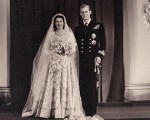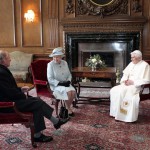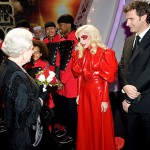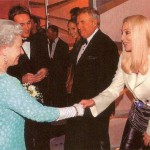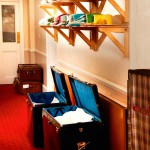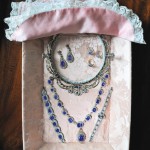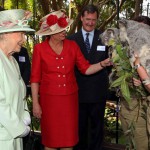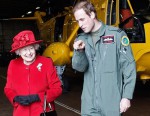Her Majesty Queen Elizabeth II
An elegant gray-haired lady with a kind look and welcoming smile has been personifying monarchy to the British people in the United Kingdom for sixty years now. Virtually all the strata of British population have sympathy for her: the prestige of the Windsor’s house, and of the whole British monarchy as well, is unshakable as ever.
The full title of the Queen of the United Kingdom Elizabeth II goes likes this, Queen Elizabeth the Second, by the Grace of God Queen of the United Kingdom of Great Britain and Northern Ireland and of Her other Realms and Territories, Head of the Commonwealth, Defender of the Faith.
Her Majesty the Queen was born on April 21 of 1926 in London. The birth of a charming little girl did not stir up the court’s excitement. Nobody could even think of the possibility that this young creature in some time would take the royal throne. At that time, Elizabeth’s grandfather George V reigned. His elder son Edward was perceived to be the apparent heir to the throne. The girl’s father, Prince Albert, was the king’s second son. He could not even allow a thought that he would become a crowned monarch.
Everyone thought that the oldest son would get married soon, have his own heirs, and after the death of his father he would receive upon himself the king’s responsibilities.
Lilibet, as everyone called Elizabeth in her childhood, loved her grandfather very much, and the latter paid back with his affection in return, although he was rather a harsh and hard man. The king had no tender feelings for his sons.
He brought them up in Spartan style and quite often was too hard on them. As a result of such training, the girl’s father developed stuttering in his speech, which he could not overcome for the rest of his life.
But for the young female creature George V had the most tender feelings. Not only did he love his granddaughter, but he adored her, which fact proved to people in his environment that even in the most cruel and callous soul there is always a light spot that is able to love in a sincere and pure way.
George V passed away from this corruptible world on January 20 of 1936 at the age of seventy years old. He reigned for twenty four years and was remembered as a wise political figure, caring for the wellbeing of his nation.
According to the legal procedure, the throne went over to Edward. He became Edward VIII, but he was never crowned. The man turned out to be unable to take on his shoulders the monarch’s heavy burden. He met a woman, who was divorced twice, named Wallis Simpson (1896-1986). In 1916, she married a military pilot, but he began to beat her up, and in 1927 Wallis was forced to run away from him.
She moved to London and “snagged” a businessman named Ernest Simpson. She married him in 1928. In 1931, at a party of her close friends Wallis met the throne’s heir. But the actual love affair between this couple started only in 1934. The affection was so strong that Simpson divorced her husband. Edward responded with no lesser love. In order to stay with Wallis, he abdicated the throne.
All these circumstances brought Elizabeth’s father – Albert Frederick to the English throne. He was crowned on May 12 of 1937 under the name of George VI.
The newly proclaimed king had no sons. Therefore, the youngest son, Henry, was announced as the throne’s heir. But he decisively declined such an honourable role in favour of Elizabeth. Therefore, at eleven years old, Elizabeth became the legal heir to the royal throne of one of the most powerful nations in the world.
In 1939, the World War II started. The girl was 13 years old at the time. On October 13 of 1940, she spoke on the radio addressing the children, who suffered during the Nazi’s bombings. And at the age of eighteen, she received a license of a driver and mechanic of a field ambulance. Until the very last days of the war, the future Queen would be at the steering wheel, carrying ailing and wounded soldiers.
When she was still a very young girl, Elizabeth fell in love once and for the rest of her life. She met her future husband right before the war at the Royal Naval College. The King with his both daughters (the youngest daughter is Margaret) came there to meet with the local cadets.
It was within the walls of this institution where the heiress of the English throne saw Greek Prince Philip. He was among the students there, and five years older than Elizabeth. The young people fellowshipped for only a couple of hours, but this time was enough for Elizabeth to fall in love with the young man seriously and for a long time.
Prince Philip had the most brilliant genealogy that could ever be found. He was a grandson of the Greek king and great grandson of the King of Denmark; also he was a great grandson of the Russian Emperor Nicolas I. But after the revolution in Greece, the prince had nothing there except his title.
During the whole war Elizabeth wrote letters to the young officer, while he was bravely fighting on a destroyer ship.
Right after the military actions were over, the heiress of the throne proposed to the Greek prince to be engaged, defying all social standards and conventions. On November 20 of 1947, the wedding took place at Westminster Abbey.
It was a hard time after the war. Elizabeth had to sell some of her jewelry to make herself a wedding dress. Ingredients for the wedding cake were sent from Australia. The cake turned out to be enormous – 3 meters tall. It was not cut with knives, instead it was cut with sables. The guests got to have only a little piece, the rest was sent to schools and hospitals.
At the end of January of 1952, the happy young couple went to Kenya for vacation. The spouses stayed at the «Tree Tops» hotel. It was built in the branches of a huge ficus. On February 7, an entry was made in the registration book, “For the first time in the whole history of human civilization, a princess climbed up a tree to come down from it as a Queen.”
The reason for this entry was the death of George VI. He died between February 5 and 6. Elizabeth automatically became Queen of the United Kingdom. In many countries of the world newspapers came out with headlines printed in bold type, “The King is Dead, Long Live the Queen.”
Coronation of Elizabeth II, Queen of the United Kingdom, took place at Westminster Abbey (the traditional place of coronation of the British monarchs) on June 2, 1953; that is, one year and 5 months after the death of George VI. But the official date of her ascension to the throne is marked as February 6 of 1952.
The husband has not been crowned. He was the first to swear loyalty to his queen and he had to leave the Navy. From that time on, his presence was needed at all official ceremonies of the royal court.
Her private life with Philip has not always been like a fairy tale. While the husband was still young, he quite often took the liberty to say some things that he had probably learned when he was in the military service. For example, when he was in New Guinea he asked someone in the street, “Tell me, my dear, how come you have not been eaten yet?”
In China he made a joking remark to one British tourist, “Be careful not to stay here for too long, or your eyes will become narrow.” In Paraguay, while meeting a murderous dictator Stressner, Philip said, “It is astonishingly pleasant to be in a country, which is not ruled by the people.”
There were rumours at the court about some love affair between Prince Philip and Elizabeth’s cousin. They talked about bastard children from different women. The Queen of the Great Britain did everything to stop such rumours. As years went by, the prince calmed down. Age and deteriorating health took their toll.
All the days of the British Queen resemble one another like two peas. Her Majesty is awakened at 8 o’clock sharp. Such an important task is entrusted to her maid. She brings to the royal bedroom a tray with tea. During this procedure, the cup’s handle should be oriented to the right, and the spoon on the saucer should be placed in a perfect diagonal way.
After putting down the tray, the maid has to open the curtains. The room is lit with sunlight, and tender rays touch the face of the sovereign. At the same time, the queen’s dogs rush into the bedroom, having come back from a morning walk. They are corgis; now there are two of them – Willow and Holly.
According to some reports, which sound more like a legend, the ritual of the morning awakening of the Queen happens in a different way. In the morning, a Scottish bagpiper comes to the royal garden and stands right under the queen’s bedroom window. At eight o’clock sharp, the bagpiper starts playing and he keeps playing until Her Majesty wakes up. After the queen wakes up, her maid opens the queen’s bedroom window to let the bagpiper know that Her Majesty the Queen is up. After that, the bagpiper leaves the garden still playing his bagpipe.
The queen drinks her morning tea, pets the dogs, while her lady-in-waiting fills a bathtub. Her Majesty takes a bath, and at nine o’clock she leaves her bedroom and goes to the dining room. Here the Queen of the United Kingdom Elizabeth II eats breakfast.
The morning meal is very simple. Toast with butter and very thin layer of marmalade goes with a cup of tea. During breakfast the sovereign flips through newspapers. They are: Times, Daily Telegraph, Daily Mail, and Sporting Life. In the last one she checks the section devoted to horse races. Her Majesty loves this sport. She knows a good deal about horses and owns several wonderful race species.
At ten o’clock, the Queen of Great Britain starts her workday. She sits at her office and looks through the letters that come to her from the whole world. There is all kinds of information in those letters. Someone is asking for help, someone is asking for recipes of an original course that had been served at the last official reception.
Then there come the turn of the state letters, that require the queen’s signature. This is a necessary formality, although the Cabinet of Ministers never asks for the queen’s opinion. Elizabeth II is free to express her view on a certain matter, but it will not have any decisive power.
From eleven o’clock, Her Majesty receives official persons. They are diplomats, judges, ministers. All of them upon entering, get down on one knee and take the queen’s right hand with their right hand, touch it with their lips, after which they get up to their feet. This ceremony lasts for no less than two hours. During that whole time the queen is standing. She has no possibility to sit down and rest.
Lunch time comes when this physically straining activity is over. Queen Elizabeth II eats sandwiches with salmon, cucumbers, or chicken. Leftovers are used the next day. They can be used for a casserole or a pie. The food that is left is never given to the dogs.
After lunch there is some little rest and an official reception. The dinner starts at fifteen minutes after eight. The whole family gathers around the table. In Great Britain the evening meal is the most substantial one of the day. Very seldom Her Majesty eats alone. It happens when all the members of the Royal family are traveling.
After dinner the queen watches TV programs, and closer to midnight she goes to bed. Elizabeth II has been living such a regular life for almost sixty years now.
The Queen of Great Britain Elizabeth II has four children. They are prince Charles (born in 1948), prince Andrew (born in 1960), princess Anna (born in 1950), prince Edward (born in 1964). Mainly the father took care of the children’s upbringing, since the queen always had many important state affairs to attend to.
The entire life of the British court is a ritual. It has been worked out throughout centuries. For example, in the staff of the Buckingham palace there is a tailor. It is her responsibility to mend socks and linen. This does not mean that the queen has no money for these petty things. The tailor has to be paid much more than the cost of new socks and sets of linen. It is just that the royal court pays tribute to tradition. Around five hundred years ago, the price for fabric was very high, and the royal persons were saving money in this way. Times have changed, but the tradition remained. It is not the only one at the royal palace.
The liveries that the servants wear have been made two hundred years ago. Every new servant is given some old uniform, which is then made fit to his figure. The total staff of attendants is over three hundred people. The staff is composed of personal pages, waiting maids, ladies-in-waiting, keepers of silverware and royal treasures. There are even pages of front rooms and back rooms.
During the official receptions, a huge table is laid. It is impossible to reach its middle even stretching. The waiters wrap up their shoes with cloths and get on the table with their feet. During the meal, the first course is served to the queen. She starts eating immediately. After that, the waiters serve courses to the guests. When the plate of the sovereign is emptied, servants immediately take the plates away from all those present. Many of the guests cannot even taste what has been served for them.
However, the queen of Great Britain Elizabeth II cancelled this not so courteous habit. She declared that no one should ever stay hungry at her table. But this is the only deviation from the ancient tradition.
As for the servants, they have to walk in the palace, staying on a narrow path near the wall. If the queen or someone from the royal family is coming straight at them, the servants have to hide somewhere. It may be some pantry, wardrobe in the wall, that is, any place to cover, which happens to be at hand. When noble ladies see the queen, they have to curtsy, while men have to take a bow.
These tradition have been kept without fail throughout many centuries. They are not tedious for people at all. On the contrary, there are many of those, who would like to serve at the royal palace. But all the offices, as a rule, are passed on from parents to their children. Children from their young age soak in the unique atmosphere of the royal palace and zealously guard its traditions and habits. It seems as if time itself stops within the walls that for many a centuries have been protecting royal sovereigns from twists and turns of the ever-changing and so unpredictable world outside.
Queen Elizabeth II loves animals very much. She breeds horses and dogs. Her favourite breed of dogs is Pembroke Welsh Corgi. A dog of this breed, which she named Susan, was presented to her by her father George VI for her birthday, when she turned eighteen years old. Elizabeth had more than thirty Pembroke Welsh Corgi; all of them were Susan’s offspring.
The royal dogs live in palaces and castles, travel in limousines with a driver, fly on private airplanes and helicopters, and accompany their noble lady everywhere she goes. There are special wicker baskets in the castle that serve as beds for dogs; they are elevated above the floor for several centimeters to avoid drafts. Dogs are allowed to walk freely in the royal apartments.
When in the beginning of 2009, two of the Elizabeth II’s Pembroke Welsh Corgi dogs died of cancer, she stopped breeding puppies. In the past, puppies of the royal dogs were never sold, they were given into good hands. Prompted by these sad occasions, in order to improve her pets’ health, she decided to interbreed miniature Dachshund nicknamed Pipkin with one of her Pembroke Welsh Corgis and received a new designer’s breed Dorgi.
Now queen Elizabeth II has two Pembroke Welsh Corgis called Willow and Holly; two Dorgi dogs named Candy and Volcano. Elizabeth II also has Labradors and Cocker Spaniels. After their death, all the four-legged pets are buried on a cemetery, which is situated on the territory of Sandringham – winter residence of the queen; and a little tombstone is erected for each one with a short obituary (for example, «HEATHER / Born May 28.1961 / Died Jan. 31.1977 / For 15 Years the / Faithful Companion / of THE QUEEN./ Great Grand Daughter of Susan»).
It is believed that the first royal Pembroke Welsh Corgi dog was Susan, which was presented by king George VI to his daughter in 1933; but according to the most recent information, love of the royal family for this breed goes back much further. During excavations in 2004 in Wales, where the queen’s ancestors lived in the 9th century, archeologists discovered a bone of a dog’s pawn belonging to the Pembroke Welsh Corgi breed.
Interesting facts from the life of Her Majesty:
Elizabeth II continues her traditional family interest of keeping homing pigeons, which springs back to 1896, when the Belgian king Leopold II presented several birds of this kind to the British royal family. In 1990, one of the royal pigeons, which later was nicknamed “Sandringham Lightning,” won a major international contest in France. Being a big lover of pigeon races, the queen is patronizing several societies of sport pigeon breeding, including the Royal Association of Sport Pigeons.
The queen has a vast collection of jewelry, the major part of which consists of so called royal insignia (crowns, scepters etc.). Other pieces of jewelry, including the largest pink diamond in the world, the queen inherited or received as gifts. Among the most famous items of crown jewelry that can be mentioned, there is a diamond brooch in the shape of a branch of Australian acacia, which was presented by the government of Australia in 1954; a necklace of large aquamarines and square-cut diamonds, and earrings, presented by the ambassador of Brazil in the year of coronation.
In 2005, the queen claimed her right on 88 young swans that lived on the Thames. The Swans’ Claimer is taking care of them. The first royal keeper of swans was appointed back the 12th century. Formally, the queen still owns all sturgeons, whales and dolphins in coastal waters of the United Kingdom. According to a law, issued in 1324 by king Edward, “The King also owns… whales and sturgeons that are caught in sea and other places within the kingdom.” The law is still active in the United Kingdom up to this day, and according to it, sturgeons, whales, and dolphins are considered to be the “royal fish.” Therefore, if they are caught within the three mile zone off the British shore, or cast upon the shore alive or dead, the crown may claim its right on them. As a rule, when fishermen return to their port they sell sturgeons in a regular way, and some customers, showing their loyalty to the throne, ask the queen to honour them and receive their humble tribute.


